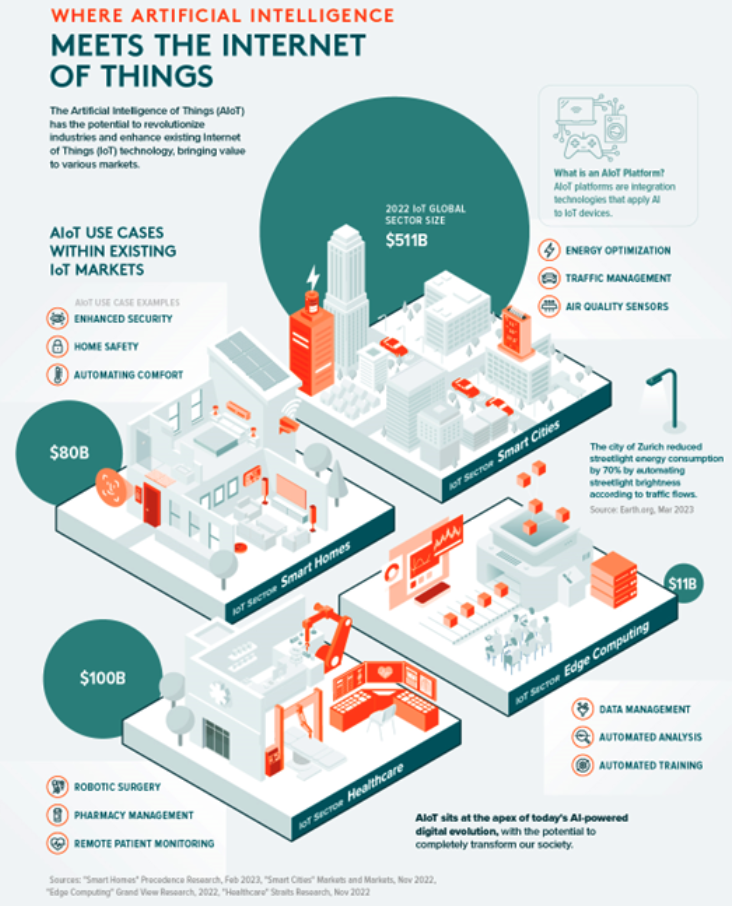
“AI Swarms embodied in hardware capabilities will transform the future”
Charting the Technological Evolution
The transition from the Internet of Things (IoT) to the Internet of Intelligent Things (AIoT) symbolizes a transformative leap in the realm of technology, embodying not just a progression in device capabilities but a fundamental shift in the interaction paradigm between devices and humans.
This evolution ushers in an era where devices are not merely interconnected but are imbued with intelligent, decision-making capabilities that promise to redefine our interaction with technology. This detailed exploration ventures into the core of AIoT, scrutinizing its foundational principles, expansive applications, and the groundbreaking role of AI SWARM in catalyzing a new age of collaborative intelligence.
From IoT to AIoT: The Integration of Intelligence
Transitioning from IoT to AIoT signifies the seamless infusion of artificial intelligence into a network of interconnected devices, propelling the ecosystem towards enhanced automation and intelligent decision-making.
IoT laid the groundwork by creating a vast network of devices capable of sharing and processing data, spanning consumer electronics to industrial sensors, revolutionizing our approach to connectivity and data utilization. AIoT elevates this foundation by incorporating AI’s analytical and predictive capabilities, enabling real-time processing, and decision-making.
This integration facilitates advancements such as predictive maintenance in industries, personalized user experiences in consumer devices, and real-time data analytics in smart cities, all processed at the edge of the network to ensure privacy, reduce latency, and lower bandwidth requirements.

AIoT’s intelligence is powered by advanced AI algorithms and machine learning models that enable devices to understand and interact with their environment in unprecedented ways. For example, natural language processing (NLP) allows AIoT devices to interpret and respond to human language, facilitating more intuitive interactions.
Predictive AI models can forecast future events based on historical data, enabling applications such as predictive maintenance and personalized health monitoring. Furthermore, the integration of computer vision and audio analysis expands the sensory capabilities of AIoT devices, allowing them to recognize images, objects, and sounds, thereby enabling applications ranging from automated surveillance to enhanced user interfaces.
The Emergence of AI SWARM in AIoT
AI SWARM introduces a paradigm of collaborative intelligence among AI agents, inspired by the collective behavior observed in natural systems such as bee swarms and bird flocks. In AIoT, this principle enables devices equipped with individual intelligence to function as part of a synergistic system.
Such collaboration not only enhances the capabilities of each device but also enables the collective to tackle complex tasks efficiently. This is particularly evident in scenarios requiring real-time data sharing and collective decision-making, such as traffic management and environmental monitoring in smart cities, where SWARM intelligence can dynamically adjust to changing conditions to optimize outcomes.
AIoT Applications: Bridging Sectors and Industries
The impact of AIoT transcends various sectors, driving innovation and efficiency at an unparalleled scale. In healthcare, AIoT devices can monitor patient health in real-time, predict medical events, and provide personalized care plans.
In agriculture, drones and sensors equipped with AIoT capabilities can monitor crop health, optimize resource usage, and automate harvesting processes. Moreover, in the realm of smart homes, AIoT devices can learn from user behaviors to automate home environments, enhancing comfort and energy efficiency. These applications are underpinned by a variety of AI models, each tailored to specific tasks, showcasing the versatile potential of AIoT to revolutionize industries and improve daily life.

Hybrid AI: Marrying Edge and Cloud Computing
Hybrid AI emerges as a key enabler for AIoT, merging the advantages of edge computing with the scalability of cloud computing. By processing data locally, edge AI addresses concerns related to privacy and latency, making AIoT devices more responsive and secure.
Conversely, cloud computing offers the computational horsepower necessary for processing large datasets and performing complex analyses. This hybrid model ensures that AIoT devices can operate efficiently in real-time while also leveraging the cloud for tasks that require substantial computational resources, thus balancing the need for immediacy and privacy with the demands for power and scalability.
Toward an Intelligent, Connected but Still Challenging Future
The journey towards a fully realized AIoT ecosystem is fraught with challenges, including ensuring interoperability among diverse devices and systems, safeguarding data privacy, and developing energy-efficient AI algorithms. Addressing these challenges requires concerted efforts in innovation, regulation, and education. Moreover, the future of AIoT will be shaped by advancements in quantum computing, 5G and beyond wireless technologies, and next-generation AI models, which promise to further enhance the capabilities of AIoT systems.

The progression from IoT to AIoT marks a significant milestone in the technological landscape, heralding a future where devices not only connect but also intelligently collaborate. This shift towards AIoT offers the promise of transforming our interaction with technology, making our environments smarter, our industries more efficient, and our lives more connected.
Embracing the principles of collaborative AI and Hybrid AI, AIoT is poised to overcome complex challenges and unlock new horizons of innovation. As we advance into this new era, the boundless potential of AIoT invites us to envision a world where technology not only serves but also anticipates and adapts to our needs, creating a more intelligent and interconnected existence.




